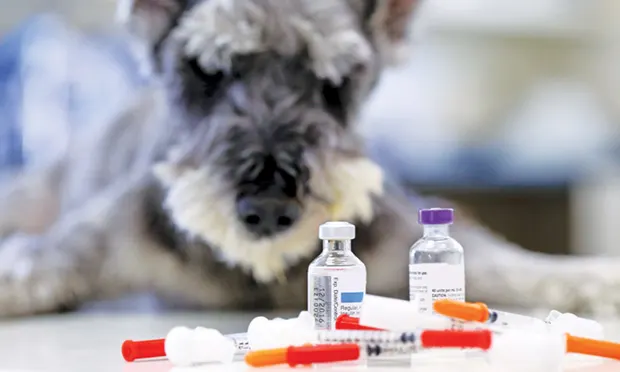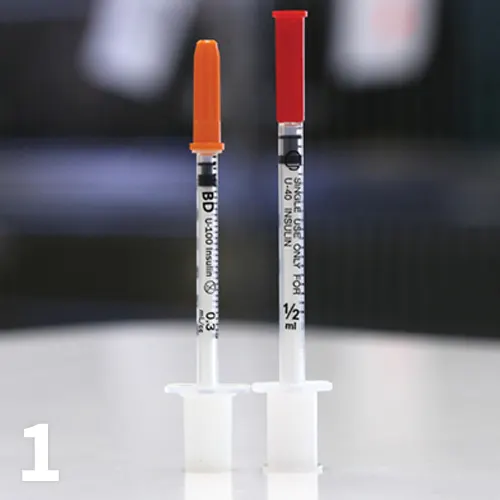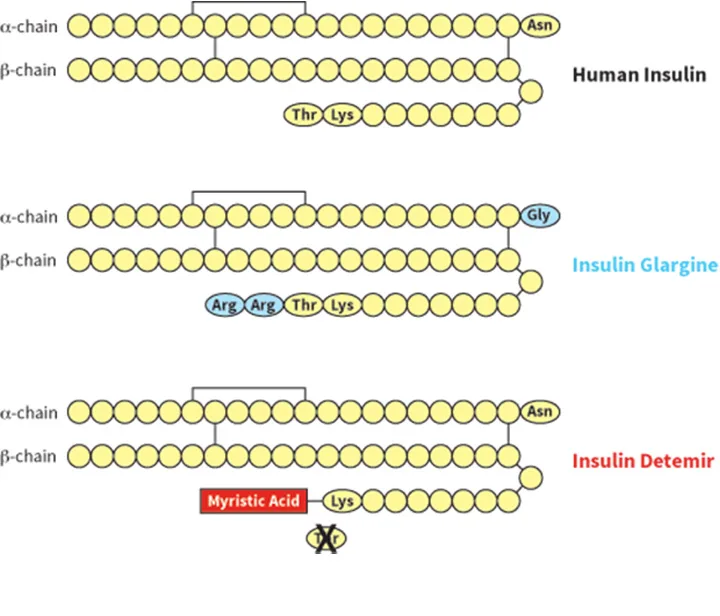Top 5 Maintenance Insulins
Ruth Gostelow, BVetMed(Hons), DACVIM, DECVIM-CA, MRCVS, Royal Veterinary College

Insulin is arguably the most important hormone involved in glucose homeostasis and is the mainstay of long-term treatment for canine and feline diabetics. Many maintenance insulins are available to veterinarians, but the most appropriate choice often depends on the species treated, clinician preference, and prescribing laws in certain countries.

40 U/mL syringes can be identified by having red caps (right), whereas 100 U/mL syringes have orange caps (left). This convention originates from human medicine.*
Debilitated diabetics can require treatment with neutral or soluble insulin before starting maintenance insulin therapy. Soluble insulin preparations contain unmodified insulin, which has a circulating half-life of only 5 minutes.1 Soluble insulin is often administered IV, or by intermittent IM injection, to provide short-term glycemic control in diabetic patients that have reduced caloric intake because of diabetic ketoacidosis, pancreatitis, or other comorbidities. Patients receiving soluble insulin typically require concurrent fluid therapy, management of electrolyte imbalances (eg, hypokalemia, hypophosphatemia), and glucose supplementation to prevent hypoglycemia once insulin has taken effect. Once stable, patients can be transitioned to intermediate- or long-acting maintenance insulins. Maintenance insulins contain additives or modifications to increase duration of action, and their concentration can vary between types, making it imperative to use compatible syringes when dosing (Figure 1). The following reviews the top 5 maintenance insulins for use in veterinary practice, in order of duration of action.
1. Neutral Protamine Hagedorn (isophane) Insulin
Duration
Intermediate-acting
Trade Name(s)
Concentration
Both 100 U/mL
Use
NPH was the first maintenance insulin to be developed and is produced through addition of zinc and protamine to soluble insulin.2 Zinc causes formation of insulin hexamers, whereas protamine binds to insulin molecules. These complexes slowly dissociate from insulin, leading to increased duration of action.3 NPH is a commonly used, twice-daily maintenance treatment for canine diabetes and provides effective control in many dogs.4,5 Duration of action can be short in certain dogs,6 so some clinicians recommend porcine lente insulin as the initial maintenance insulin of choice for canine diabetes.7 NPH has been used as a twice-daily maintenance insulin in diabetic cats and can lead to diabetic remission in some patients.8 Duration of action is often insufficient, so longer-acting maintenance insulins are recommended for feline diabetics.7
Dosages
Starting dose is 0.3 to 0.4 U/kg twice daily in dogs5 and is not preferred in cats because of short duration of action.
2. Porcine Lente Insulin (Porcine Insulin Zinc Suspension)
Duration
Intermediate-acting
Trade Name(s)
Vetsulin (USA), Caninsulin (Europe)
Concentration
Both veterinary preparations are 40 U/mL
Use
Commonly used as a twice-daily maintenance treatment for canine diabetes worldwide and feline diabetes in Europe. Duration of action is increased through addition of zinc. Twice-daily porcine lente insulin effectively controls glycemia in most dogs with uncomplicated diabetes.9 Some feline diabetics can achieve good control with twice-daily porcine lente, but average length of action is 8 hours in cats, leading many clinicians to recommend longer-acting insulins when treating feline diabetes.10,11 Twice-daily porcine lente has been associated with diabetic remission rates of 25% and 43% when used alongside a low-carbohydrate diet in cats.12,13
Dosages
Starting doses are 0.25 U/kg twice daily in dogs14 and 1 to 2 U/cat twice daily15
3. Protamine Zinc Insulin (PZI)
Duration
Long-acting
Trade Name(s)
Concentration
40 U/mL (ProZinc)
Use
Like NPH, PZI has increased duration of action through addition of protamine and zinc but contains a higher protamine concentration, giving it a longer duration of action. It is commonly used as a twice-daily maintenance insulin in diabetic cats because it has a longer duration of action than porcine lente insulin.16 A remission rate of 38% has been reported in diabetic cats treated with twice-daily PZI and a low-carbohydrate diet.12 Protamine zinc insulin is also a suitable alternative for dogs that are poorly controlled using porcine lente insulin.17
Dosages
Starting dose is 0.2–0.7U/kg twice daily18 for cats and 0.25–0.5 U/kg twice daily for dogs17
4. Insulin Glargine
Duration
Long-acting
Trade Name
Concentration
100 U/mL
Changes made to the human insulin sequence in the development of insulin glargine and insulin detemir.

Use
Glargine is a long-acting insulin analogue produced by recombinant DNA technology. Prolonged action results from substituting an asparagine amino acid with glycine in the human insulin α-chain and the addition of 2 arginine molecules to the β-chain (Figure 2). This makes glargine less soluble at physiologic pH, causing it to precipitate when injected into subcutaneous tissues. These precipitations slowly dissociate into glargine monomers, causing prolonged insulin release.19 Glargine is a popular twice-daily maintenance insulin in cats and is considered by some clinicians to be the optimum insulin to promote diabetic remission.20 Remission rates of 64% to 100% have been reported using glargine in diabetic cats fed low-carbohydrate diets,12,21 although other studies have reported lower rates of 14%22 and 40%.23 Glargine has a longer duration of action than porcine lente insulin and could provide superior remission rates compared to that insulin type.16 Detemir and PZI have similar durations of action to glargine and could provide comparable remission rates in diabetic cats.16,24 Two small studies have examined twice-daily glargine treatment in canine diabetes.25,26 Although 1 study found that all dogs achieved good diabetic control approximately 40 days after starting therapy, the other reported that only 58% of dogs achieved good glycemic control. Furthermore, other authors reported disappointing results when using glargine in canine diabetics.7 Detemir is therefore a more popular choice for some clinicians in diabetic dogs poorly controlled on porcine lente or PZI.7
Dosages
Starting dose is 0.25 to 0.5 U/kg twice daily in both cats and dogs20,26
5. Insulin Detemir
Duration
Long-acting
Trade Name
Levemir (levemir.com)
Concentration
100 U/mL
Use
Detemir is another long-acting insulin analogue produced by recombinant technology. Its extended action results from substituting a threonine in the insulin β-chain with a myristic acid residue (Figure 2). Myristic acid reversibly binds to albumin. These complexes gradually dissociate; this results in prolonged insulin release.27 Detemir is used as an effective twice-daily maintenance insulin for cats and was reported to result in a remission rate of 67% when used in a treatment protocol aimed at euglycemia alongside a low-carbohydrate diet.28 Another study, however, reported a lower remission rate of 21% when twice-daily detemir was used in a standard protocol in practice.29 Detemir is the longest-acting insulin in dogs with some residual insulin action still present 24 hours after injection.30 Detemir is administered at a lower dose than other insulins when used twice daily in dogs. This can make dose adjustments challenging in dogs weighing <5 kg. Published experience of twice-daily detemir in canine diabetics is limited. Effective glycemic control was reported by 2 small studies, including 1 study that showed better control after 5 days of therapy compared to insulin glargine.30,31
Dosages
Starting dose is 0.25 to 0.5 U/kg twice daily in cats20 and 0.1 U/kg twice daily in dogs7
Conclusions
Neutral insulin therapy is used during initial stabilization of unstable diabetics with complicated or comorbid conditions. Many canine diabetics can be stabilized on twice-daily NPH or porcine lente treatment, whereas longer-acting insulins or insulin analogues may provide better glycemic control, and greater chance of remission, in cats.
*UPDATE: Regarding the caption for Figure 1, it has recently become apparent that some 40 U/l syringes are now being produced with orange caps. Pet owners should therefore be careful to check that their pet's syringes have the correct calibration and should not entirely rely on the color of a syringe's cap.